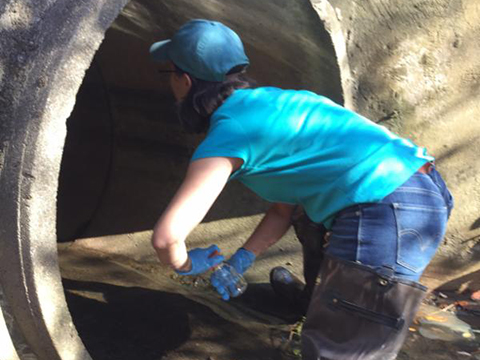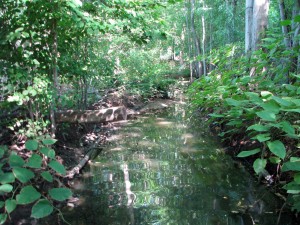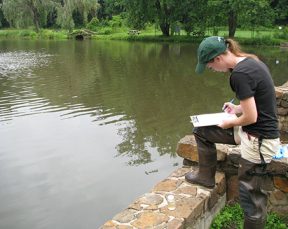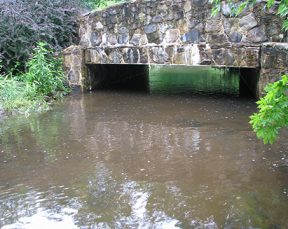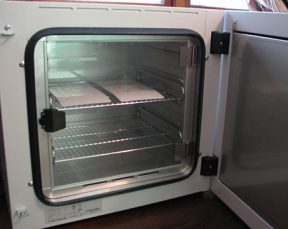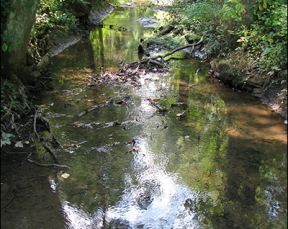As I wrote in my last blog post, we have seen very high E. coli in upstream Loantaka Brook — particularly at our site LB4M just downstream from Morris Township’s Ginty Pool, and LB5 upstream from there. In conjunction with Morris Township’s engineer, I have been conducting follow-up E. coli monitoring to better determine what the source(s) of high E. coli might be and where it could be coming from.
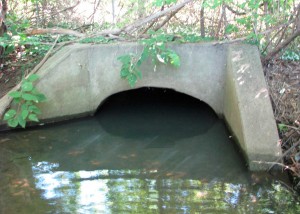

The sample at LBE was collected from where this culvert meets Loantaka Brook (photo taken on 8/27/2015)
We have conducted three rounds of follow-up testing so far. In addition to LB4M and LB5 mentioned above, monitoring sites are located at a culvert about 400’ upstream from Woodland Ave. (LBE), and in Loantaka Brook about 50’ further upstream (LBW). A map of the site locations can be seen by clicking here. To see the follow-up results, click here.
During the last sample collection round on 8/27/2015, I was joined by Darren and Albert who run the lab at Morris Township’s Butterworth Water Pollution Control Utility (wastewater treatment plant). The lab has been processing the last few rounds of samples for us. Darren and Albert joined me in the field to see the monitoring sites and get a better sense of what might be causing the high E. coli levels.
After we collected samples from LB5, LBE, and LBW, we walked further upstream along the field behind Morris Township’s Woodland Elementary School. We saw a few pipes entering the stream, but it was difficult to tell if they had any flow since there were partially submerged in the stream. Some areas of the stream had very clear flowing water (though clear doesn’t always mean healthy since much of what we test for isn’t visible to the naked eye).
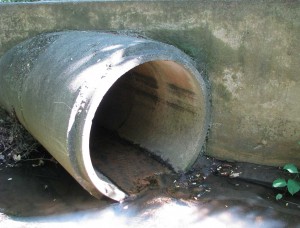

This pipe is approximately 4’ in diameter. We aren’t sure what it normally discharges to Loantaka Brook, but during dry weather on 8/27/2015 it had a low flow
One large pipe close to the school did have a flow. We are investigating with the Morris Township engineer what this pipe should carry and if there should be a flow from it during dry weather. This might be a potential source of E. coli.
Aside from the large pipe, the only other obvious E. coli source that we noticed could be wildlife. There were many raccoon and some deer prints in muddy bars along the edges of the stream. However, with many homes in the area, dogs are also a potential source since not everyone picks up after their pet – although they should!
We walked as far upstream as we could, until there was a wall in front of us and the stream was coming out of a pipe under Parsons Village.
What Comes Next?
We would like to continue to collect samples in Loantaka Brook, upstream of LBW in several locations, particularly upstream and downstream from the 4’ pipe that was flowing on our visit. Collecting several samples between LBW and Parsons Village will help us determine the location where the E. coli is coming from.
Morris Township is planning to use a camera in their sewer lines in the area to check for leaking pipes. Our sampling results will help them figure out where to start this process.
NJDEP is willing to do some source tracking analysis. Source tracking uses antibiotic resistance to determine if E. coli colonies are from humans, domestic animals, or wildlife. (Since humans are exposed to lots of different types of antibiotics, E. coli from humans will be resistant to many types of antibiotics. E. coli from domestic animals will be resistant to some types of antibiotics, while E. coli from wildlife won’t be resistant to any types of antibiotics.)
Additional sampling and source tracking work will happen in late September. Stay tuned for more information as we continue to investigate!
